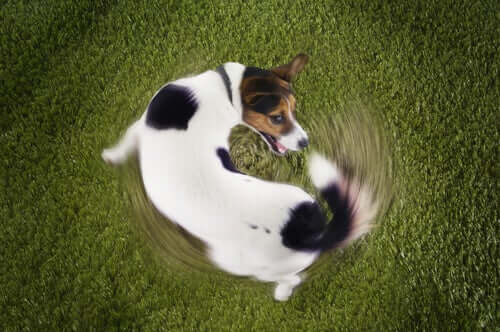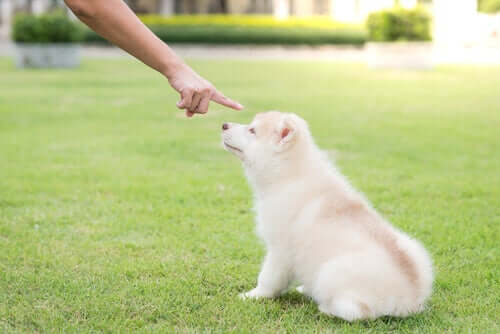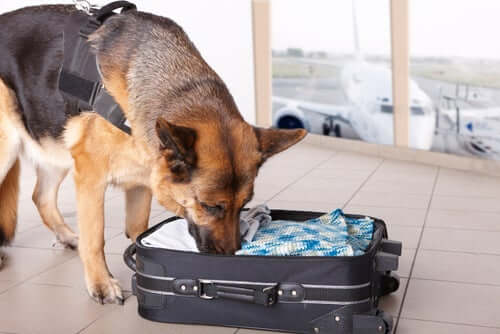Hyperactivity in Pets: How to Handle Lockdown

Without a doubt, you’re aware that some animals are more active than others… perhaps from your own experiences or those of family, friends, or neighbors. For example, staying indoors for long periods of time isn’t the same for an English Bulldog as it is for a Husky or a Dalmatian. Today, we’ll offer some tips to help you make the most of the lockdown period as you deal with hyperactivity in pets.
You need to keep in mind that, according to breed, upbringing, and other factors, some pets may be more or less active than others. These factors can offer valuable clues when it comes to developing strategies to help us channel their behavior and improve the situation at home.
Hyperactivity in pets: Factors to keep in mind

Just like any other sort of behavior in dogs, hyperactivity can sometimes be a characteristic that passes down from generation to generation. But its origin may also have to do with factors that aren’t genetic, for example:
- Insufficient stimulation. Both physical and mental.
- Lack of socialization. This can be the cause behind a number of behavior problems in a dog’s life. It’s very common among dogs that are separated from their mothers at an early age. The same is true for pets from stores that sell puppies after they’ve reached the age of 3 months, once the socialization period is over.
- Lack of routine. Animals adapt very easily to daily routines which offer a sense of security. Routines help them know when they’re going to eat, go outdoors, sleep, etc.
- Hyperkinesis. This is a condition similar to attention deficit disorder in human beings and is the result of problems in an animal’s nervous system.
- Nutritional problems. Both an excessive intake of calories as well as nutritional hypersensitivity (food allergies) can contribute to hyperactivity in pets.
- Learning. The learning of behavior reinforced by the owner, either voluntarily or involuntarily.
Overactivity vs. hyperactivity in pets?
Hyperactivity and overactivity are two different things. In fact, you can find differences between one and the other in many aspects.
- Overactivity is somewhat more common in dogs.
- Unlike hyperactivity, overactivity doesn’t have to do with physiological alterations in a dog. Nor does it have to do with the animal’s ability to relax or sleep normally.
- However, just the opposite is true when a dog is hyperactive. Heart rate, respiratory rate, and temperature are all higher, even during periods of rest.
- Activity in overactive dogs has a purpose. In other words, it’s not an exaggerated reaction to stimuli, such as in cases of hyperactivity in pets. Often, the purpose is to get the attention of the animal’s owner.
- Overactivity is not an inheritable trait.
Many dogs are labeled as “hyperactive” when actually they aren’t. Rather, they simply have higher levels of activity in comparison to other dogs of the same breed or age. What’s more, it’s important to remember that activity levels vary from one individual to another.
Advice for dealing with overactivity in pets during lockdown
If your veterinarian has already ruled out organic problems as the cause of your pet’s hyperactivity, then you can apply these tips in your everyday life and consider alternatives for long periods at home, like our current circumstances.
1. Don’t reinforce hyperactive behaviors
It’s important to avoid reinforcing hyperactivity in pets and rewarding situations where your dog reacts in an exaggerated way. Nor should you use punishment in these events. The only thing you’ll achieve is increasing your dog’s anxiety levels, which is just the opposite of what you want.

2. Establish a routine
It’s important to establish routines when it comes to walks, play, rest, and meals. Depending on an animal’s breed and age, it’s best to give them one or two separate meals per day.
3. Adjust your pet’s diet to meet its needs
You should make sure that the amount of food you’re offering is right for your pet, considering its breed, age, ideal weight, and activity level. The nutritional needs of a Labrador pup are very different from that of an elderly Chihuahua.
4. Offer sufficient mental and physical stimulation
Pet owners must also be sure that their dogs get enough stimulation, both on a physical and mental level. Of course, your dog’s needs will vary according to breed and age.
Be careful not to resort to extreme exercises that leave your dog exhausted. Nor should you settle for minimal routines that don’t challenge your pet at all. Dogs need to burn off excess energy, so it’s important to find the right balance. For example:
- At home, you can practice smelling, stretching and chewing exercises. You can also prepare toys using items you have around the house, like cardboard toilet paper tubes.
- Games that require dogs to use their sense of smell offer physical stimulation as well as mental stimulation.
- For the most agile breeds, like herders, hunters, and spaniels, you can gradually incorporate more difficult exercises like running on a treadmill.

5. Training at home
We can train your dog with different self-control and obedience commands and exercises (“sit”, “still”, “outside”, “seek”, etc.). In this sense, maximizing self-control at home is very important in dealing with hyperactivity in pets.
With time and practice, you can avoid out-of-control situations, such as your dog pouncing on its food, for example.
Correcting behavior in order to improve your situation at home
Just like quarantine affects some people more than others, the same is true for our pets. Some breeds are more energetic and need their owners to help them channel their impulses. Others, however, are more relaxed in general.
Regardless of an animal’s nature, every dog requires special attention during quarantine in order to make the most of the situation. If you focus on getting to know your pet even better, you can correct bad habits and improve your time together at home. The benefits won’t only help during lockdown, but in the future as well.